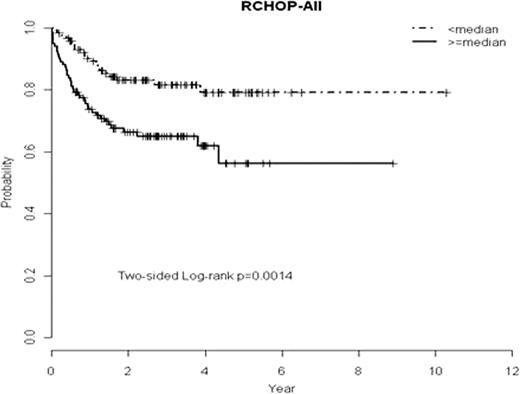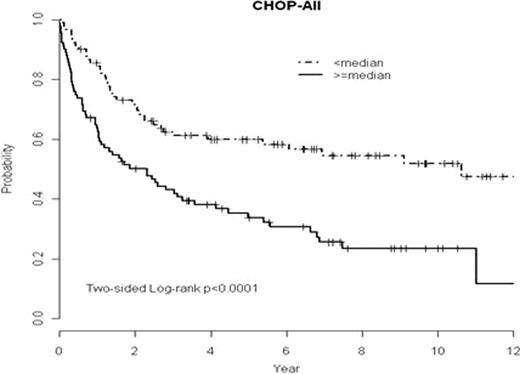Abstract
Abstract 87
The International Prognostic Index (IPI) remains the most powerful predictor of clinical outcome in DLBCL in the R-CHOP era, serving as a useful surrogate for the biology we are just beginning to understand. With a follow-up of more than 9 years, its uniformly staged and treated patients and its prospectively collected unstained slides for correlative studies, the clinical data set from E4494, the US Intergroup trial comparing CHOP and RCHOP in patients >60 years with DLBCL, stands as a valuable resource for investigating prognosis in DLBCL. Based on immunohistochemistry, we previously showed that rituximab modulates the prognostic significance of some biomarkers in DLBCL. With these same specimens, the quantitative nuclease protection assay (qNPA), a methodology for measuring mRNA levels in FFPET, was used to develop separate prognostic signatures for the CHOP and RCHOP arms that can be simply applied using stored unstained slides.
Five micron unstained FFPET sections from 183 eligible and evaluable cases enrolled on E4494 and submitted for prospective immunohistochemical correlative studies more than ten years ago were used for this analysis. Tissue was scraped from slides and a multiplexed qNPA was performed in triplicate using a customized Array Plate assay (HTG, Inc) for 43 genes of interest. TBP served as a housekeeping gene. Association between standardized log gene expression and patient failure-free survival (FFS) and overall survival (OS) was obtained using the Cox proportional hazards model. A weighted analysis was used to eliminate the confounding effect of maintenance rituximab. Genes that showed at least marginal significance in the univariate analysis were used to perform LASSO (penalized method to select best subset) to select a final list of genes in the multivariate analysis. Using the predictive model for either CHOP or R-CHOP induction, individual risk scores were calculated based on the multivariable model, and cases were dichotomized into low and high risk groups based on the median risk score. The model was then validated using the Lenz dataset (NEJM, 2008).
In six cases, tissue from slides prepared >10 years ago was compared to freshly cut sections from corresponding blocks, and showed excellent concordance (corr=0.86). On-study characteristics for the 176 cases with analyzable data were representative of the greater E4494 patient population. Six gene predictors were developed for each arm of the trial: RCHOP: FN1, LMO2, AKT1, HIF1a, AKT3, BCL2; and CHOP: PDCD4, HLADRB1, COL3A1, LMO2, ROBO4, TP53. Both signatures proved powerful predictors of FFS and OS among CHOP (FFS: p=0.0031; OS: p=0.0013) and RCHOP (FFS: p=0.001; OS=p=0.0015) treated patients. When adjusted for the clinically-based IPI, the gene-risk score retained its significance (CHOP: FFS p=0.0007; OS p=0.0011; RCHOP: FFS p=0.003; OS, p=0.001) while the IPI became only marginally significant (CHOP: FFS: p=0.06, OS p=0.06; R-CHOP: FFS p=0.09, OS p=0.02), suggesting that the gene predictor accounted for much of the predictive power of the IPI.
The predictive model was then validated using the Lenz dataset for OS. The predictor models for CHOP and R-CHOP-treated patients effectively dichotomized patients into prognostic subgroups (CHOP: p<0.0001; RCHOP: p=0.0014; see figure below) and this difference was maintained when the subset over age 60 was analyzed (CHOP: p=0.0008; RCHOP: p=0.017). When adjusted for the IPI, the molecular predictor developed for CHOP treated patients remained robust (OS: P=.0001; HR 2.39), while the molecular predictor for RCHOP predicted OS marginally (p=.06; HR 1.82), with shorter followup than the CHOP cohort.
Unstained slides from FFPET stored for many years may be used to investigate gene expression in lymphoma biopsy specimens for which there is mature followup. Gene risk scores based on the expression of a limited number of genes are powerful predictors of clinical outcome.
Pollock:HTG, Inc.: Employment, Equity Ownership. Botros:HTG, Inc.: Employment, Equity Ownership. Horning:Genentech: Employment, Equity Ownership.
Author notes
Asterisk with author names denotes non-ASH members.



This feature is available to Subscribers Only
Sign In or Create an Account Close Modal